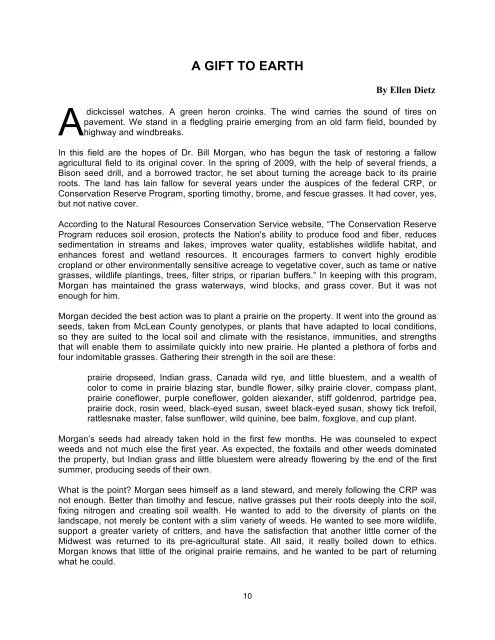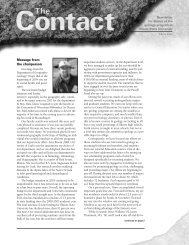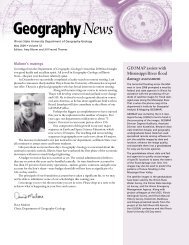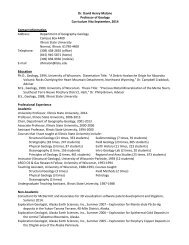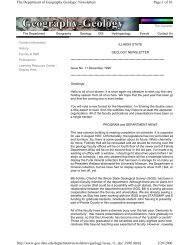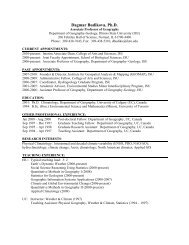Glacial Deposits.indd - Department of Geography - Geology - Illinois ...
Glacial Deposits.indd - Department of Geography - Geology - Illinois ...
Glacial Deposits.indd - Department of Geography - Geology - Illinois ...
Create successful ePaper yourself
Turn your PDF publications into a flip-book with our unique Google optimized e-Paper software.
A GIFT TO EARTH<br />
By Ellen Dietz<br />
A<br />
dickcissel watches. A green heron croinks. The wind carries the sound <strong>of</strong> tires on<br />
pavement. We stand in a fledgling prairie emerging from an old farm field, bounded by<br />
highway and windbreaks.<br />
In this field are the hopes <strong>of</strong> Dr. Bill Morgan, who has begun the task <strong>of</strong> restoring a fallow<br />
agricultural field to its original cover. In the spring <strong>of</strong> 2009, with the help <strong>of</strong> several friends, a<br />
Bison seed drill, and a borrowed tractor, he set about turning the acreage back to its prairie<br />
roots. The land has lain fallow for several years under the auspices <strong>of</strong> the federal CRP, or<br />
Conservation Reserve Program, sporting timothy, brome, and fescue grasses. It had cover, yes,<br />
but not native cover.<br />
According to the Natural Resources Conservation Service website, “The Conservation Reserve<br />
Program reduces soil erosion, protects the Nation's ability to produce food and fiber, reduces<br />
sedimentation in streams and lakes, improves water quality, establishes wildlife habitat, and<br />
enhances forest and wetland resources. It encourages farmers to convert highly erodible<br />
cropland or other environmentally sensitive acreage to vegetative cover, such as tame or native<br />
grasses, wildlife plantings, trees, filter strips, or riparian buffers.” In keeping with this program,<br />
Morgan has maintained the grass waterways, wind blocks, and grass cover. But it was not<br />
enough for him.<br />
Morgan decided the best action was to plant a prairie on the property. It went into the ground as<br />
seeds, taken from McLean County genotypes, or plants that have adapted to local conditions,<br />
so they are suited to the local soil and climate with the resistance, immunities, and strengths<br />
that will enable them to assimilate quickly into new prairie. He planted a plethora <strong>of</strong> forbs and<br />
four indomitable grasses. Gathering their strength in the soil are these:<br />
prairie dropseed, Indian grass, Canada wild rye, and little bluestem, and a wealth <strong>of</strong><br />
color to come in prairie blazing star, bundle flower, silky prairie clover, compass plant,<br />
prairie coneflower, purple coneflower, golden alexander, stiff goldenrod, partridge pea,<br />
prairie dock, rosin weed, black-eyed susan, sweet black-eyed susan, showy tick trefoil,<br />
rattlesnake master, false sunflower, wild quinine, bee balm, foxglove, and cup plant.<br />
Morgan’s seeds had already taken hold in the first few months. He was counseled to expect<br />
weeds and not much else the first year. As expected, the foxtails and other weeds dominated<br />
the property, but Indian grass and little bluestem were already flowering by the end <strong>of</strong> the first<br />
summer, producing seeds <strong>of</strong> their own.<br />
What is the point Morgan sees himself as a land steward, and merely following the CRP was<br />
not enough. Better than timothy and fescue, native grasses put their roots deeply into the soil,<br />
fixing nitrogen and creating soil wealth. He wanted to add to the diversity <strong>of</strong> plants on the<br />
landscape, not merely be content with a slim variety <strong>of</strong> weeds. He wanted to see more wildlife,<br />
support a greater variety <strong>of</strong> critters, and have the satisfaction that another little corner <strong>of</strong> the<br />
Midwest was returned to its pre-agricultural state. All said, it really boiled down to ethics.<br />
Morgan knows that little <strong>of</strong> the original prairie remains, and he wanted to be part <strong>of</strong> returning<br />
what he could.<br />
10


